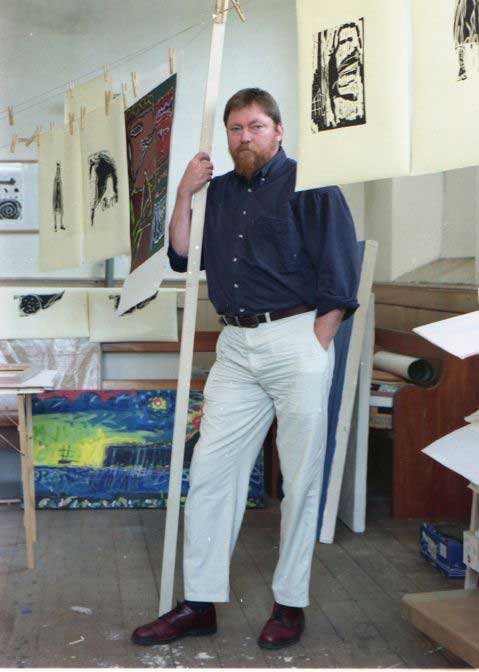William Brown: Painter and printmaker

The painter and printmaker William Brown triumphantly achieved Picasso's ambition of drawing like a child. "I steal ideas, usually from children, because they're smaller," he freely confessed. But his pictures are more serious than they look.
Brown described himself as a narrative painter; not a believer in abstraction, he used colour "as an excuse to hang the stories on". The colour is pure and the lines deceptively simple; the stories, though, are extraordinarily mixed. An inveterate traveller, Brown collected myths the way other people collect souvenirs, weaving them into fabulous painted tapestries featuring the world's great bogymen. Against heraldic fields of colour, cartoon figures of the French-Canadian werewolf Loup Garou and the Welsh grey mare Mari Lwyd project a faintly comic air of menace, serving as "nagging reminders of the animal in the human". The carnival atmosphere clearly recalls James Ensor, though other artistic influences are more surprising – one recurring still-life composition (the "Kipper Nocturne"), featuring a kipper lying on a table, with the moon shining in through a window, apparently owed its inspiration to Chardin.
Literary influences were also credited – Rimbaud appeared in a recent painting beside his amputated leg (the wrong one). And politics were never far out of the picture. In a series of paintings recalling a visit to Tripoli during the US air strikes, a black fighter plane disrupts the blue of a perfect bay, while Approaching Storm, Berguette (1997) is an apocalyptic vision in which the little church at Guarbecque in Pas de Calais, birthplace of Brown's friend the poet Lucien Suel – with whom he collaborated on the book Le Nouveau Bestiaire that year – descends out of a black cloud on to the Newport Transporter Bridge. "He's a tricky fellow, this Brown," wrote the Newport Town Poet Goff Morgan; "warms you up with a tot of irony, then drops the chill ice-cube of millennial anxiety down the back of your neck".
Born in Toronto to Scottish parents in 1953, Brown studied fine art in Ontario and sculpture in Pittsburgh before moving in 1977 with his first wife Jodie Brennan to Somerset, where he taught at the College of Arts and Technology. When his marriage broke down, he moved to London and got work as a painter and decorator. Then, in 1987, on an artist's residency at a Devon junior school, he fell in love with the deputy head teacher Carys Griffiths. A man later described by his dealer David Solomon as a cross between Jacques Tati and David Bellamy was an unlikely match for a deputy head teacher, but they married the following year and moved to South Wales in 1991.
In Wales the wandering artist put down roots. He learnt Welsh, became a member of the Welsh Group and the Old Library Artists and established himself as a prominent figure on the literary scene, enlivening poetry volumes such as David Greenslade's March (1998) with his vivid woodcuts, burnished with the back of a spoon. A 1996 touring exhibition "What's Behind the Blanket", organised by the Glynn Vivian Gallery in Swansea, brought his paintings to national attention, and he was taken on by David Solomon's East West Gallery in Notting Hill, where he exhibited regularly from 1997.
A prodigious sketcher to the end – "I draw like other people knit" – in 1999 Brown supplied the drawings for an animated music video promoting the Welsh group Gorky's Zygotic Mynci, which had the distinction of winning an award at a Canadian film festival despite the failure of the sound system. His copious correspondence, in his inimitable (and sometimes incomprehensible) "pidgin" of English, Welsh and French, was liberally laced with drawings. One example, framed in the lavatory at East West, depicts Van Gogh's bedroom in Arles with the caption: "Don't sit on that chair, Paul, I've just painted it."
As a former member of the Cold War Mailart movement – for communicating with fellow artists behind the Iron Curtain using the outsides of letters rather than the insides, so as to discombobulate the Communist censors – Brown took as much trouble with the outside of a letter as the inside. Decorated with rubber stamps, scribbled mottoes and drawings, his envelopes had everything on them except the postcode and consequently often took weeks to arrive, or were returned. But Alison Lloyd, as exhibition officer at the Glynn Vivian, recognised them as artworks in their own right and had a set framed for "What's Behind the Blanket".
Laura Gascoigne
William Brown, painter and printmaker: born Toronto, Ontario 11 December 1953; twice married (one daughter); died Bridgend 17 July 2008.
Join our commenting forum
Join thought-provoking conversations, follow other Independent readers and see their replies
Comments
Bookmark popover
Removed from bookmarks